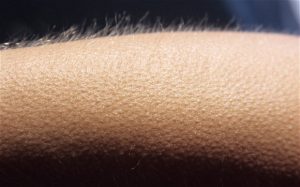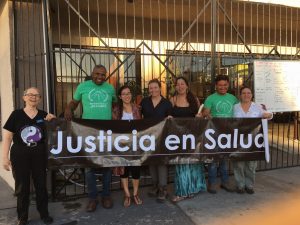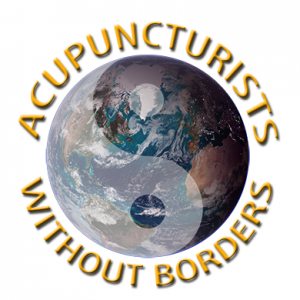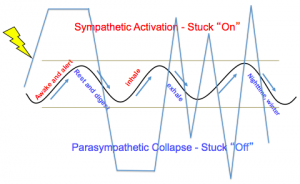Trauma Training Tip

The skin and body hair correspond with the Metal. In presence of threat, our skin wakes up with “goose bumps” and the hair on the back of our neck may stand up. Our skin is our largest organ, our fundamental armor and our essential container. It keeps the outside world out and the inside world in.
Our skin’s role in the Self Protective Response is to alert us to something new in our external environment. It has richly sensate experiences about the nature, location, quality, and kind of touch it likes or dislikes. In fact, it is a highly intelligent body system.
Skin differentiates “me” and “not me”; self and other. It houses nerve endings that help us pay attention. Mindful touch on the skin can help create a safe, secure, and respectful relational field when working with trauma survivors. Research has shown that comforting touch can decrease cortisol production, mediate the pain response, increase dopamine, serotonin, and oxytocin, and regulate cardiac tone.

Our goals for touching the skin are to:
- Support containment and an increased capacity to expand around volatile states without losing stability.
- Create a tactile interface that helps differentiate “me” and “not me.”
- Build coherence between and among body systems or tissues — and to support integration and assimilation of emotional states.
Alaine’s Two Cents
The Refugee Health Alliance was formed in response to multiple communities escaping violence, poverty, and discrimination. They initially sought to help mobilize Southern California providers and their networks down to the Tijuana/San Diego international border to aid in the refugee crisis. They are leading the way in navigating the dynamics of preserving the dignity of their clients and at the same time receiving the assistance of North American health providers.
Instead of asking us for “cultural competence,” they have asked us for “cultural humility.” I like it so much better.
None of us can possibly be competent in a culture we have not been steeped in since we were children. However, we can grow our humility in our relationship with the magnificence of how people manifest life in so many rich ways.
Here’s a TEDx Talk about privilege that they ask their North American volunteers to watch.https://www.youtube.com/watch?v=XlRxqC0Sze4
 Check This Out!
Check This Out!
Here’s one of my favorite stories from my experience earlier this month with Acupuncturists Without Borders at the Refugee Health Alliance in Tijuana, Mexico.
This fellow’s main complaint was “stress” and insomnia. I treated his Fire Element while one of my acu-pals held his freezing cold kidneys. They warmed up with her hand, the needles, and some moxa. When we finished and we asked him to reflect on how he felt, he said: “I know that my body is made up of many parts, but now those many parts are one — I am one, I am whole.” He was full of smiles and hugs whenever we saw him the rest of the week.
 My conclusion: traumatic stress is a vibrational illness, and needs vibrational medicine. His treatment created an integrating vibration inside him — and now everyone his smile lands on is getting a treatment too.
My conclusion: traumatic stress is a vibrational illness, and needs vibrational medicine. His treatment created an integrating vibration inside him — and now everyone his smile lands on is getting a treatment too.
Acupuncturists Without Borders continues to host a series of service trips to the Enclave Caracol Clinic (sponsored by the Refugee Health Alliance) in Tijuana, Mexico.
These service trips provide trauma and pain relief treatments to asylum-seekers, immigrants, refugees, and community support volunteers in the Tijuana-San Diego area. AWB already has a similar project in Texas. You can read more about it here.
Donations to support this effort help make it happen! You can donate here if you are so moved.
Clinical Curiosity
Where is your clinical curiosity carrying you?
Send me a question or two and I will explore them with readers in this corner next month.
Q. In the last month, I had someone show up on my table who had been hit by a car by the white supremacist in Charlottesville and another person from Parkland, Florida. It felt a little unreal to be a small part of the aftermath of such nationally-visible traumatic events, and also all too real. I wonder what your thoughts are about how the very public nature of certain traumas impacts people and what to be aware of or offer differently in that context?
A. So important!
We are hard-wired to be vulnerable to fear. Our biology commands us to take actions to ensure our survival – and so we are made to be highly responsive to circumstances that appear threatening. This is why it is illegal to yell “fire” in a crowded movie theatre – stampedes of fearful people can result. Nationally, there are media outlets and politicians who are metaphorically yelling “fire” and we see the contracted, rigid, and narrow-minded responses – and violence – that arise from the creation of this sense of threat.
However—our survival also requires us to know when we are safe – even only “a little bit” safe in order to protect our capacity for complex thought, creative responses, and compassionate understanding. We are tribal animals – and in order to protect the integrity of our communities, we also need to know when we are truly safe, even when we have been told to be afraid. Our communities can be shattered by false presentations of fear by voices that yell “fire.” We need our communities!
Highly visible traumatic circumstances, like Charlottesville and Parkland, can take us all down the rabbit hole of constant hyper-arousal. We are gripped by overwhelming fear when we become habituated to a sense of threat – what Stephen Porges calls the “Dorsal Vagal neurological platform.” We will fail to attune to the loving, supportive, and safe communities that are also part of our world. Experiences of safety and relationship can help us disagree without contracting – we can take firm positions against racist, homophobic, and xenophobic violence – but remain in our hearts and operate from our frontal cortex instead of our reactive and fear-filled hindbrain – when we have experiences of safety in relationships.
 When any of us have an opportunity, like you have, to help such survivors access and embody even a small sense of safety in the course of your treatment, it will help restore their “Ventral Vagus neurological platform” – and restore access to their frontal cortex. They will be able to more effectively find creative, complex, and thoughtful responses that can be effective in meeting the challenges we face in our local and national discourse – ones that are life-giving, flexible and expanding, instead of contracting and impulsive.
When any of us have an opportunity, like you have, to help such survivors access and embody even a small sense of safety in the course of your treatment, it will help restore their “Ventral Vagus neurological platform” – and restore access to their frontal cortex. They will be able to more effectively find creative, complex, and thoughtful responses that can be effective in meeting the challenges we face in our local and national discourse – ones that are life-giving, flexible and expanding, instead of contracting and impulsive.
So glad these two individuals found their way to you. So very glad.

